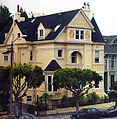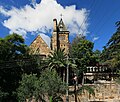Seni bina Victoria

Istilah Seni bina Victoria dapat merujukkan pada salah satu dari sebilangan gaya seni bina yang utamanya digunakan sewaktu zaman Victoria. Dengan yang kedua, zaman bangunan yang ia meliputi mungkin sedikit bertindih pemerintahan yang sebenarnya, 20 Jun 1837 – 22 Januari 1901, dari Ratu Victoria selepas siapa namanya diberikan, menyimpan dengan suatu adat British dan Perancis dengan mana gaya-gaya seni bina telah dinamakan selepas ratu yang memerintah.
Kepelbagaian seni bina Victoria
Gaya ditanggap sewaktu zaman Victoria
- Arts and Crafts movement British
- Seni bina Industri
- Painted Ladies
- Queen Anne (Stick-Eastlake)
- Emnpayar Kedua (seni bina)
- Jacobethan (the precursor to the Queen Anne style)
- Neo-Grec
- Renaissance Revival
- Romanesque Revival (includes Richardsonian Romanesque)
Gerakan lain dimasyhurkan sewaktu zaman itu
While not uniquely Victorian, and part of revivals that began before the era, these styles are strongly associated with the Victorian era due to the large number of examples that were erected in that period
- Gothic Revival
- Italianate
- Neoclassicism
International spread of Victorian styles
In the early 19th century the romantic medieval gothic style appeared as a backlash to the symmetry of Palladianism, and such buildings as Fonthill Abbey were built. By the middle of the 19th century, as a result of new technology, construction was able to develop incorporating steel as a building component; one of the greatest exponents of this was Joseph Paxton, architect of the Crystal Palace. Paxton also continued to build such houses as Mentmore Towers, in the still popular retrospective Renaissance styles. In this era of prosperity and development English architecture embraced many new methods of construction, but ironically in style, such architects as Augustus Pugin ensured it remained firmly in the past.
In Canada, Alexander Thomson was a pioneer in the use of cast iron and steel for commercial buildings, blending neo-classical conventionality with Egyptian and oriental themes to produce many truly original structures.
In the 18th century a few English architects had emigrated to the colonies, but as the British Empire became firmly established in the 19th century many architects at the start of their careers made the decision to emigrate. Several chose the United States, and others went to Canada, Australia, and New Zealand. Normally the style of architecture they adopted was those which were fashionable when they left England, though by the latter half of the century improving transport and communications meant that even quite remote parts of the Empire had access to the many publications such as The Builder magazine that enabled colonial architects to stay abreast of current fashion. Thus the influence of English architecture spread across the world. Several prominent architects produced English-derived designs around the world, including William Butterfield (St Peter's Cathedral, Adelaide) and Jacob Wrey Mould (Chief Architect of Public Works in New York City).
-
 Palace of Westminster, Victorian Gothic completed in 1870. Designed by Sir Charles Barry and August Pugin
Palace of Westminster, Victorian Gothic completed in 1870. Designed by Sir Charles Barry and August Pugin -
 The Victorian Pavilion at The Oval cricket ground in London.
The Victorian Pavilion at The Oval cricket ground in London. -
 Victorian School of Art and Science at Stroud, Gloucestershire
Victorian School of Art and Science at Stroud, Gloucestershire -
 House on the Hardwick House estate near Bury St Edmunds, Suffolk
House on the Hardwick House estate near Bury St Edmunds, Suffolk -
 Victorian slums in Wetherby, West Yorkshire
Victorian slums in Wetherby, West Yorkshire -
 The Aston Webb building at the University of Birmingham, UK.
The Aston Webb building at the University of Birmingham, UK. -
 The Gilbert Scott Building of University of Glasgow, as viewed from Kelvingrove Park, Glasgow. An example of the Gothic Revival style.
The Gilbert Scott Building of University of Glasgow, as viewed from Kelvingrove Park, Glasgow. An example of the Gothic Revival style. -
 The front elevation of the Glasgow City Chambers, as seen from George Square, Glasgow.
The front elevation of the Glasgow City Chambers, as seen from George Square, Glasgow.
North America
There are also Folk and Shingle Style Victorian houses. The names of architectural styles (as well as their adaptations) varied between countries. Many homes combined the elements of several different styles and are not easily distinguishable as one particular style or another. In the USA, highly decorated houses are sometimes called gingerbread houses.
Notable Victorian era cities include Astoria, Oregon (USA), Albany, New York (USA), Boston (USA), Brooklyn (USA), Buffalo (USA), Chicago (USA), Detroit (USA), Galena, Illinois (USA), Galveston, Texas (USA), Glasgow (UK), Grand Rapids, Michigan (USA), Jersey City/Hoboken (USA), Kolkata (India), London (UK), Louisville, Kentucky (USA), Manchester (UK), Mumbai (India), Nelson, New Orleans (USA), Philadelphia (USA), Pittsburgh (USA), Richmond (USA), Saint Paul, Minnesota (USA), San Francisco (USA), St. Louis, Missouri (USA), Toronto (Canada).
In the USA, the South End of Boston is recognized by the National Register of Historic Places as the oldest and largest Victorian neighborhood in the country.[1][2] Old Louisville in Louisville, Kentucky also claims to be the nation's largest Victorian neighborhood.[3][4]
Richmond, Virginia is home to several large Victorian neighborhoods, the most prominent being The Fan and Church Hill. Church Hill has the distinction of being the place where Patrick Henry gave his famous Give me liberty or give me death speech at historic Saint John's church. The Fan is best known locally as Richmond's largest and most 'European' of Richmond's neighborhoods and nationally as the largest contiguous Victorian neighborhood in the United States.[5]
The Distillery District in Toronto contains the largest and best preserved collection of Victorian-era industrial architecture in North America. Cabbagetown is the largest and most continuous Victorian residential area in North America. Other Toronto Victorian neighbourhoods include The Annex, Corktown, Parkdale, and Rosedale.
The photo album L'Architecture Americaine by Albert Levy published in 1886 is perphaps the first recognition in Europe of the new forces emerging in American architecture.[6]
The Old West End neighborhood of Toledo, Ohio is recognized as having the largest collection of late Victorian and Edwardian homes in the United States, east of the Mississippi.[7]
Carroll Avenue in Los Angeles contains that city's highest concentration of Victorian homes.
-
 Example of an early Victorian "Gingerbread House" in the USA, built in 1855
Example of an early Victorian "Gingerbread House" in the USA, built in 1855 -
 The California Southern Railroad's San Diego, California passenger terminal, built in 1887.
The California Southern Railroad's San Diego, California passenger terminal, built in 1887. - An example of the American Queen Anne style in Lebanon, Illinois.
-
 A Victorian house in Alameda, California
A Victorian house in Alameda, California -
 Banff Springs Hotel, built in 1888
Banff Springs Hotel, built in 1888 -
 Michelsen Farmstead built in 1899, is a Victorian style farmstead that is a Provincial Historic Site of Alberta located in the National Historic Site, Stirling, Alberta, Canada.
Michelsen Farmstead built in 1899, is a Victorian style farmstead that is a Provincial Historic Site of Alberta located in the National Historic Site, Stirling, Alberta, Canada. -
 The C. A. Belden House, a Queen Anne Victorian in the Pacific Heights section on Gough Street Between Clay and Washington Streets. The house is on the National Register of Historic Places in San Francisco.
The C. A. Belden House, a Queen Anne Victorian in the Pacific Heights section on Gough Street Between Clay and Washington Streets. The house is on the National Register of Historic Places in San Francisco. -
Australia
In Australia, the Victorian period is generally recognised as going from 1840 to 1890. There were fifteen styles that predominated:[9]
|
|
|
|
|
The Arts and Crafts style and Queen Anne style are placed in the Federation Period, from 1890 to 1915.[10]
-
 Melbourne's world heritage Royal Exhibition Building, built in 1880 (Free Classical)
Melbourne's world heritage Royal Exhibition Building, built in 1880 (Free Classical) -
 Rialto Building, Melbourne, built during the land boom of 1888 (Free Gothic)
Rialto Building, Melbourne, built during the land boom of 1888 (Free Gothic) - Winahra, Mayfield, New South Wales (Filigree/Italianate)
-
 Glentworth House, Ashfield, New South Wales (Italianate)
Glentworth House, Ashfield, New South Wales (Italianate) -
 The Abbey, Annandale, New South Wales (Free Gothic)
The Abbey, Annandale, New South Wales (Free Gothic) -
 Town Hall, Sydney from The Powerhouse Museum Collection (Second Empire)
Town Hall, Sydney from The Powerhouse Museum Collection (Second Empire) -
 Former General Post Office, Sydney (Free Classical)
Former General Post Office, Sydney (Free Classical)
See also
- Victorian decorative arts
- Victorian house
- Albert Levy (photographer)
- Coffin corner (architecture)
- Georgian architecture
- Gallery of Victorian styles in Sydney
References
- ^ South End Realty Group
- ^ South End Historical Society
- ^ "Louisville Facts & Firsts". LouisvilleKy.gov. Diarkibkan daripada yang asal pada 2014-10-06. Dicapai pada 2009-12-14.
- ^ "What is Old Louisville?". Old Louisville Guide. Dicapai pada 2009-12-14.
- ^ "The Fan District - Great Public Spaces | Project for Public Spaces (PPS)". Diarkibkan daripada yang asal pada 2008-12-01. Dicapai pada 2010-03-22.
- ^ "American Victorian Architecture", by Arnold Lewis and Keith Morgan. 120 photos. Dover publications, 1975
- ^ Stine, L. (2005) Historic Old West End Toledo, Ohio. Bookmasters.
- ^ “Saitta House - Report Part 1 Diarkibkan 2008-12-16 di Wayback Machine”,DykerHeightsCivicAssociation.com
- ^ A Pictorial Guide to Identifying Australian Architecture, Apperly (Angus and Robertson) 1994, pp.40-97
- ^ A Pictorial Guide to Identifying Australian Architecture, pp.132-143
- Dixon, Roger and Muthesius, Stephan. Victorian architecture. Thames & Hudson: 1978. ISBN 0-500-18163-2
- Prentice, Helaine Kaplan, Rehab Right, Ten-Speed Press. ISBN 0-89815-172-4, includes descriptions of different Victorian and early 20th Century architectural styles common in the San Francisco Bay Area, particularly Oakland, and detailed instructions for repair and restoration of details common to older house styles.
External links
- History and Style of Victorian Architecture and Hardware
- Manchester, a Victorian City
- Photographs of Victorian Homes in Hamilton, Ontario Canada
- Victorian era architecture in San Francisco, California
- Victorian era architecture and history in Buffalo, New York
- Architectural influences on Victorian style















![The Saitta House, Dyker Heights, Brooklyn, New York built in 1899 is designed in the Queen Anne Style.[8]](http://upload.wikimedia.org/wikipedia/commons/thumb/4/42/Saitta_House_Dyker_Heights.JPG/90px-Saitta_House_Dyker_Heights.JPG)















